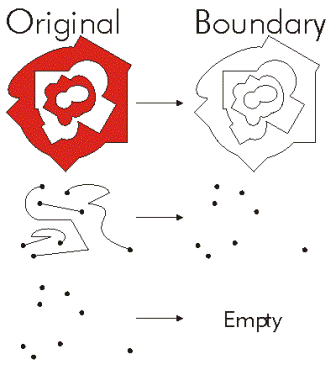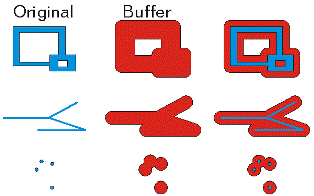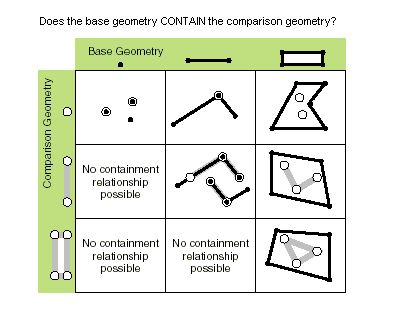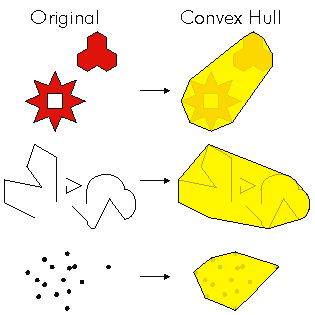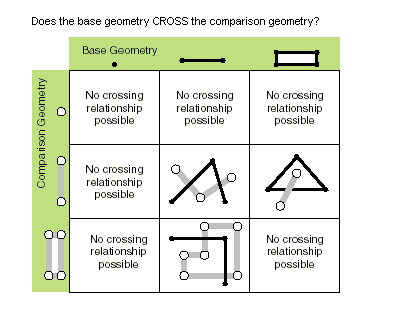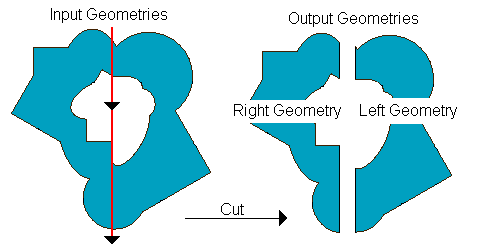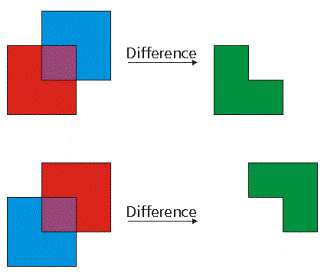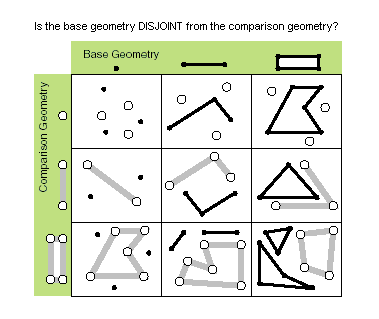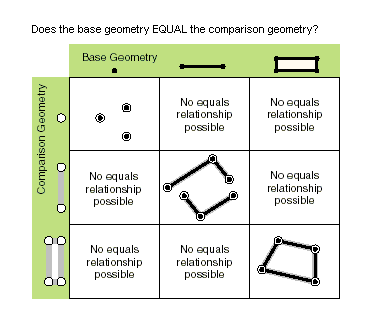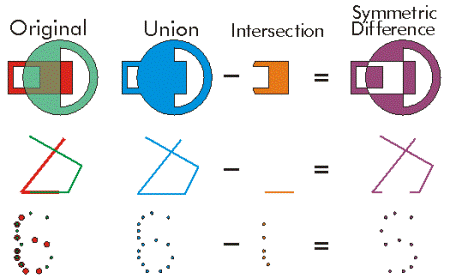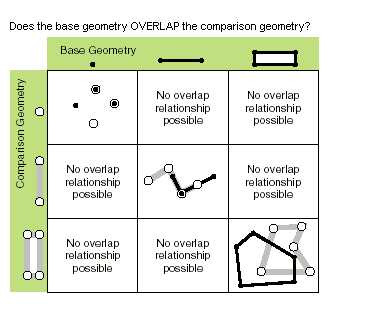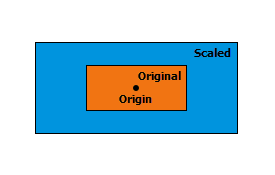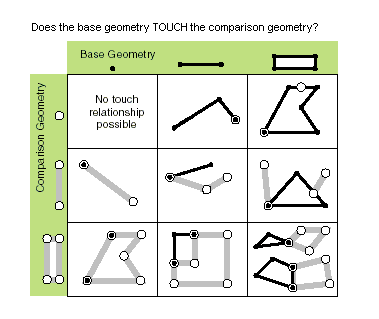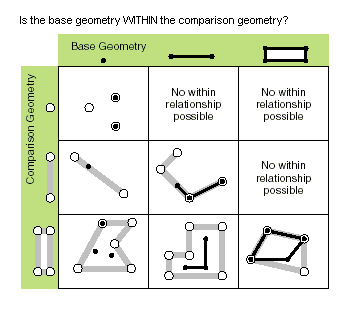Zusammenfassung
Geometry objects define a spatial location and an associated geometric shape.
Diskussion
In many geoprocessing workflows, you may need to run a specific operation using coordinate and geometry information but don't necessarily want to go through the process of creating a new (temporary) feature class, populating the feature class with cursors, using the feature class, then deleting the temporary feature class. Geometry objects can be used instead for both input and output to make geoprocessing easier. Geometry objects can be created from scratch using Geometry, Multipoint, PointGeometry, Polygon, or Polyline classes.
During the creation of a geometry object, a simplification process is performed to make the geometry topologically consistent according to its geometry type. For instance, it rectifies polygons that may be self-intersecting or contain incorrect ring orientations. Coordinates may move within the resolution of the geometry's spatial reference.
Syntax
Geometry (geometry, inputs, {spatial_reference}, {has_z}, {has_m}, {has_id})| Parameter | Erläuterung | Datentyp |
geometry | The geometry type.
| String |
inputs | The coordinate information used to create the object. The data type can be Point or Array objects. | Object |
spatial_reference | The spatial reference of the new geometry. (Der Standardwert ist None) | SpatialReference |
has_z | Specifies whether the geometry will be z-enabled. (Der Standardwert ist False) | Boolean |
has_m | Specifies whether the geometry will be m-enabled. (Der Standardwert ist False) | Boolean |
has_id | Specifies whether the geometry will support point IDs. (Der Standardwert ist False) | Boolean |
Eigenschaften
| Eigenschaft | Erläuterung | Datentyp |
| JSON (Schreibgeschützt) | An Esri JSON representation of the geometry as a string. Tipp:The returned string can be converted to a dictionary using the json module's loads function. | String |
| WKB (Schreibgeschützt) | The well-known binary (WKB) representation for OGC geometry. This property provides a portable representation of a geometry value as a contiguous stream of bytes. | Bytearray |
| WKT (Schreibgeschützt) | The well-known text (WKT) representation for OGC geometry. This property provides a portable representation of a geometry value as a text string. Any true curves in the geometry will be densified into approximate curves in the WKT string. | String |
| area (Schreibgeschützt) | The area of a polygon feature. The area is zero for all other feature types. | Double |
| centroid (Schreibgeschützt) | The true centroid if it is within or on the feature; otherwise, it is the label point. | Point |
| extent (Lesen und schreiben) | The extent of the geometry. | Extent |
| firstPoint (Schreibgeschützt) | The first coordinate point of the geometry. | Point |
| hasCurves (Schreibgeschützt) | Specifies whether the geometry has a curve. | Boolean |
| hullRectangle (Schreibgeschützt) | A space-delimited string of the coordinate pairs of the convex hull rectangle. | String |
| isMultipart (Schreibgeschützt) | Specifies whether the number of parts for the geometry is more than one. | Boolean |
| labelPoint (Schreibgeschützt) | The point at which the label is located. This point is always located within or on a feature. | Point |
| lastPoint (Schreibgeschützt) | The last coordinate of the feature. | Point |
| length (Schreibgeschützt) | The length of the linear feature. The calculation uses 2D Cartesian mathematics. For point and multipoint geometry, the length will be zero. For polygon geometry, the length will be the 2D length of the boundary. | Double |
| length3D (Schreibgeschützt) | The 3D length of the linear feature. The calculation uses 3D Cartesian mathematics. For point and multipoint geometry, the length will be zero. For polygon geometry, the length will be the 3D length of the boundary. Vorsicht:The operation does not perform unit conversion between the horizontal and the vertical coordinate systems. The x, y, and z coordinates are assumed to be in the same linear unit. Vorsicht:This property is only available for projected data. | Double |
| partCount (Schreibgeschützt) | The number of geometry parts for the feature. | Integer |
| pointCount (Schreibgeschützt) | The total number of points for the feature. | Integer |
| spatialReference (Schreibgeschützt) | The spatial reference of the geometry. | SpatialReference |
| trueCentroid (Schreibgeschützt) | The center of gravity for a feature. | Point |
| type (Schreibgeschützt) | The geometry type: polygon, polyline, point, or multipoint. | String |
Methodenübersicht
| Methode | Erläuterung |
| angleAndDistanceTo (other, {method}) | Returns a tuple of angle and distance to a point or polygon. |
| boundary () | Construct the boundary of the geometry.
|
| buffer (distance) | Construct a polygon at a specified distance from the geometry.
|
| clip (envelope) | Constructs the intersection of the geometry and the specified extent. 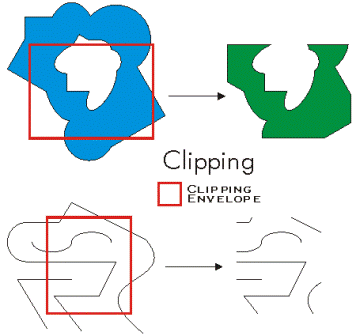 |
| contains (second_geometry, {relation}) | Specifies whether the base geometry contains the comparison geometry. The contains method is the opposite of the within method. Only True relationships are shown in this illustration.
|
| convexHull () | Constructs the geometry that is the minimal bounding polygon such that all outer angles are convex.
|
| crosses (second_geometry) | Specifies whether the two geometries intersect in a geometry of a lesser shape type. Two polylines cross if they share only points in common, at least one of which is not an endpoint. A polyline and a polygon cross if they share a polyline or a point (for a vertical line) in common on the interior of the polygon that is not equivalent to the entire polyline. Only True relationships are shown in this illustration.
|
| cut (cutter) | Split the geometry into a part left of the cutting polyline, and a part right of it. When a polyline or polygon is cut, it is split where it intersects the cutter polyline. Each piece is classified as left of or right of the cutter. This classification is based on the orientation of the cutter line. Parts of the target polyline that do not intersect the cutting polyline are returned as part of the right of result for that input polyline. If a geometry is not cut, the left geometry will be empty (None).
|
| densify (method, distance, {deviation}) | Creates a geometry with added vertices. |
| difference (other) | Construct the geometry that is composed only of the region unique to the base geometry but not part of the other geometry. The following illustration shows the results when the red polygon is the source geometry:
|
| disjoint (second_geometry) | Specifies whether the base and comparison geometries have points in common. Two geometries intersect when this method returns False. Only True relationships are shown in this illustration.
|
| distanceTo (other) | Returns the minimum distance between two geometries. The distance is in the units of the geometry's spatial reference. If the geometries intersect, the minimum distance is 0. Both geometries must have the same projection. |
| equals (second_geometry) | Specifies whether the base and comparison geometries are of the same shape type and define the same set of points in the plane. This is a 2D comparison only; m- and z-values are ignored. Only True relationships are shown in this illustration.
|
| generalize (max_offset) | Creates a simplified geometry using a specified maximum offset tolerance. |
| getArea ({method}, {units}) | Returns the area of the feature using a measurement method. |
| getLength ({method}, {units}) | Returns the length of the feature using a measurement method. |
| getPart ({index}) | Returns an Array object of Point objects for a particular part of the geometry if an index is specified. If an index is not specified, an Array object containing an Array of Point objects for each geometry part is returned. The getPart method is equivalent to indexing an object; that is, obj.getPart(0) is equivalent to obj[0]. |
| intersect (other, dimension) | Constructs a geometry that is the geometric intersection of the two input geometries. Different dimension values can be used to create different shape types. The intersection of two geometries of the same shape type is a geometry containing only the regions of overlap between the original geometries.
For faster results, test whether the two geometries are disjoint before calling intersect. |
| measureOnLine (in_point, {use_percentage}) | Returns a measure from the start point of this line to the in_point. |
| move ({dx}, {dy}, {dz}) | Moves a geometry by specified distances along the x-, y-, and z-axes to create a new geometry. |
| overlaps (second_geometry) | Specifies whether the intersection of the two geometries has the same shape type as one of the input geometries and is not equivalent to either of the input geometries. Only True relationships are shown in this illustration.
|
| pointFromAngleAndDistance (angle, distance, {method}) | Returns a point at a given angle in degrees and distance in the units of the geometry's spatial reference using the specified measurement type. |
| positionAlongLine (value, {use_percentage}, {geodesic}) | Returns a point on a line at a specified distance from the beginning of the line. |
| projectAs (spatial_reference, {transformation_name}) | Projects a geometry from one spatial reference to another. When the geometry object and the destination spatial reference do not have a common datum, specify a transformation_name parameter value. For more information, see Geographic datum transformations and ListTransformations. A vertical transformation will be performed when the following criteria are met:
When the transformation_name parameter value is a vertical transformation, and neither the geometry object nor the destination spatial reference have a vertical coordinate system, the function will fail with a ValueError exception. If either the geometry object or the spatial_reference parameter value have an unknown spatial reference, the output geometry's spatial reference will be that of the spatial_reference parameter value. Use of unknown spatial reference is not recommended for analysis. The projectAs method will not modify m-values, if present. |
| queryPointAndDistance (in_point, {as_percentage}) | Finds the point on the polyline nearest to the in_point and the distance between those points. It also returns information about the side of the line the point is on as well as the distance along the line where the nearest point occurs. |
| rotate ({origin}, {rotation_angle}) | Rotates a geometry around a specified origin by the degrees given in radians. The rotation is applied relative to the origin, so that the geometry rotates around the origin. The position of the rotated geometry is significantly affected by the choice of origin. Rotate does not apply to the z-direction. The following describes a few possible choices for the origin and its affect on the output:
|
| scale ({origin}, {sx}, {sy}, {sz}) | Scales a geometry from a specified origin by specified factors along the x-, y-, and z-axes to create a new geometry. The position of a transformed point (or vertex) is given by The transformation is applied relative to the origin, so that the origin remains stationary while the geometry expands or contracts around it. The position and the direction of the expansion or contraction for the resulting geometries is significantly affected by the origin. The following describes a few possible choices for the origin and its affect on the output:
|
| segmentAlongLine (start_measure, end_measure, {use_percentage}) | Returns a Polyline between start and end measures. It is similar to the Polyline.positionAlongLine method but will return a polyline segment between two points on the polyline instead of a single point. |
| snapToLine (in_point) | Returns a new point based on a point snapped to this geometry. |
| symmetricDifference (other) | Constructs the geometry that is the union of two geometries minus the intersection of those geometries. The two input geometries must be the same shape type.
|
| touches (second_geometry) | Specifies whether the boundaries of the geometries intersect. Two geometries touch when the intersection of the geometries is not empty, but the intersection of their interiors is empty. For example, a point touches a polyline only if the point is coincident with one of the polyline end points. Only True relationships are shown in this illustration.
|
| union (other) | Constructs the geometry that is the set-theoretic union of the input geometries. The two geometries must have the same shape type. The result is a single geometry that is the combination of both input geometries. Anything within either of the input geometries will be part of the result. However, anything that is common to both geometries will only exist once in the result. The order of the input geometries has no effect on the output.
|
| within (second_geometry, {relation}) | Specifies whether the base geometry is within the comparison geometry. The within method is the opposite operator of the contains method. Only True relationships are shown in this illustration.
The base geometry is within the comparison geometry if the base geometry is the intersection of the geometries, and the intersection of their interiors is not empty. The within method is a Clementini operator, except in the case of an empty base geometry. |
Methoden
angleAndDistanceTo (other, {method})| Parameter | Erläuterung | Datentyp |
other | The second geometry. If the geometry is a polygon, the distance is measured to the centroid of the polygon. | PointGeometry |
method | Specifies the method that will be used to measure distance.
(Der Standardwert ist GEODESIC) | String |
| Datentyp | Erläuterung |
| tuple | Returns a tuple of angle (in degrees) and distance (in meters) to another point. |
boundary ()
| Datentyp | Erläuterung |
| Object | A polygon's boundary is a polyline. A polyline's boundary is a multipoint, corresponding to the endpoints of the line. A point or multipoint's boundary is an empty point or multipoint. |
buffer (distance)
| Parameter | Erläuterung | Datentyp |
distance | The buffer distance. The buffer distance is in the same units as the geometry that is being buffered. A negative distance can only be specified for a polygon geometry. | Double |
| Datentyp | Erläuterung |
| Polygon | The buffered polygon geometry. |
clip (envelope)
| Parameter | Erläuterung | Datentyp |
envelope | An Extent object used to define the clip extent. | Extent |
| Datentyp | Erläuterung |
| Object | An output geometry clipped to the specified extent. |
contains (second_geometry, {relation})| Parameter | Erläuterung | Datentyp |
second_geometry | A second geometry. | Object |
relation | Specifies the spatial relationship type that will be used.
(Der Standardwert ist None) | String |
| Datentyp | Erläuterung |
| Boolean |
Returns whether this geometry contains the second geometry. |
convexHull ()
| Datentyp | Erläuterung |
| Object | The resulting geometry. The convex hull of a single point is the point itself. |
crosses (second_geometry)
| Parameter | Erläuterung | Datentyp |
second_geometry | A second geometry. | Object |
| Datentyp | Erläuterung |
| Boolean | Returns whether the two geometries intersect in a geometry of a lesser shape type. |
cut (cutter)
| Parameter | Erläuterung | Datentyp |
cutter | The cutting polyline geometry. | PolyLine |
| Datentyp | Erläuterung |
| Geometry | A list of two geometries. |
densify (method, distance, {deviation})| Parameter | Erläuterung | Datentyp |
method | The method of densification.
| String |
distance | The maximum distance between vertices. The actual distance between vertices will usually be less than the maximum distance, as new vertices will be evenly distributed along the original segment. If using a type of DISTANCE or ANGLE, the distance is measured in the units of the geometry's spatial reference. If using a type of GEODESIC, the distance is measured in meters. | Double |
deviation | Densify uses straight lines to approximate curves. You use deviation to control the accuracy of this approximation. The deviation is the maximum distance between the new segment and the original curve. The smaller its value, the more segments will be required to approximate the curve. If using a type of DISTANCE, the deviation is measured in the units of the geometry's spatial reference. If using a type of ANGLE, the deviation is measured in radians. If using a type of GEODESIC, the deviation is not used. | Double |
| Datentyp | Erläuterung |
| Geometry | The densified geometry. |
difference (other)
| Parameter | Erläuterung | Datentyp |
other | A second geometry. | Object |
| Datentyp | Erläuterung |
| Object | The resulting geometry. |
disjoint (second_geometry)
| Parameter | Erläuterung | Datentyp |
second_geometry | A second geometry. | Object |
| Datentyp | Erläuterung |
| Boolean | Returns whether the two geometries have points in common. |
distanceTo (other)
| Parameter | Erläuterung | Datentyp |
other | A second geometry. | Object |
| Datentyp | Erläuterung |
| Double | The distance between the two geometries. |
equals (second_geometry)
| Parameter | Erläuterung | Datentyp |
second_geometry | A second geometry. | Object |
| Datentyp | Erläuterung |
| Boolean |
Returns whether the two geometries are of the same shape type and define the same set of points in the plane. |
generalize (max_offset)
| Parameter | Erläuterung | Datentyp |
max_offset | The maximum offset tolerance. | Double |
| Datentyp | Erläuterung |
| Geometry | The generalized geometry. |
getArea ({method}, {units})| Parameter | Erläuterung | Datentyp |
method | The method used to measure area.
(Der Standardwert ist GEODESIC) | String |
units | The units in which the area will be calculated.
| String |
| Datentyp | Erläuterung |
| Double | The area of the feature. By default, for projected coordinate systems, area will be returned in the units of the coordinate system, and for geographic coordinate systems, area will be returned in square meters. |
getLength ({method}, {units})| Parameter | Erläuterung | Datentyp |
method | The method used to measure length.
(Der Standardwert ist GEODESIC) | String |
units | The units in which the length will be calculated.
| String |
| Datentyp | Erläuterung |
| Double | The length of the feature. By default, for projected coordinate systems, length will be returned in the units of the coordinate system, and for geographic coordinate systems, length will be returned in meters. |
getPart ({index})| Parameter | Erläuterung | Datentyp |
index | The index position of the geometry. | Integer |
| Datentyp | Erläuterung |
| Array | The resultant Array object. |
intersect (other, dimension)
| Parameter | Erläuterung | Datentyp |
other | The second geometry. | Object |
dimension | Specifies the topological dimension (shape type) of the resulting geometry.
| Integer |
| Datentyp | Erläuterung |
| Object | A new geometry (point, multipoint, polyline, or polygon) that is the geometric intersection of the two input geometries. |
measureOnLine (in_point, {use_percentage})| Parameter | Erläuterung | Datentyp |
in_point | A point (PointGeometry or Point) that is used to measure from the start point of the polyline. If the point does not intersect the line, the function will use the nearest location on the line from the point. | PointGeometry |
use_percentage | If False, the measure will be returned as a distance; if True, the measure will be returned as a percentage. (Der Standardwert ist False) | Boolean |
| Datentyp | Erläuterung |
| Double | The distance or percentage value. |
move ({dx}, {dy}, {dz})| Parameter | Erläuterung | Datentyp |
dx | The distance the geometry will be moved along the x-axis. (Der Standardwert ist 0.0) | Double |
dy | The distance the geometry will be moved along the y-axis. (Der Standardwert ist 0.0) | Double |
dz | The distance the geometry will be moved along the z-axis. The geometry must be z-aware and have z-values. (Der Standardwert ist 0.0) | Double |
| Datentyp | Erläuterung |
| Geometry | An output geometry, moved by the specified distances along the x-, y-, and z-axes. |
overlaps (second_geometry)
| Parameter | Erläuterung | Datentyp |
second_geometry | A second geometry. | Object |
| Datentyp | Erläuterung |
| Boolean | Returns whether the intersection of the two geometries has the same dimension as one of the input geometries. |
pointFromAngleAndDistance (angle, distance, {method})| Parameter | Erläuterung | Datentyp |
angle | The angle in degrees to the returned point. | Double |
distance | The distance in the units of the geometry's spatial reference to the returned point. | Double |
method | Specifies the method that will be used to measure distance.
(Der Standardwert ist GEODESIC) | String |
| Datentyp | Erläuterung |
| PointGeometry | Returns a point at a given angle and distance in degrees and meters. |
positionAlongLine (value, {use_percentage}, {geodesic})| Parameter | Erläuterung | Datentyp |
value | The distance along the line. The distance will be evaluated based on the geodesic parameter value. If the geodesic parameter value is False, the distance will be evaluated in meters. If the geodesic parameter value is True, the distance will be evaluated in the units of the feature's spatial reference. If the value exceeds the length of the line or precedes the length of the line (a negative value), the behaviour will depend on the geodesic parameter value as follows:
| Double |
use_percentage | Specifies whether the distance is specified as a fixed unit of measure (False) or a ratio of the length of the line (True). For percentages, express the value parameter as a double from 0.0 (0 percent) to 1.0 (100 percent). Hinweis:This parameter is only supported when the geodesic parameter value is False. (Der Standardwert ist False) | Boolean |
geodesic | Specifies whether the distance measure will be geodesic (True) or planar (False). (Der Standardwert ist False) | Boolean |
| Datentyp | Erläuterung |
| PointGeometry | The point on the line at a specified distance from the beginning of the line. |
projectAs (spatial_reference, {transformation_name})| Parameter | Erläuterung | Datentyp |
spatial_reference | The spatial reference to which the geometry will be projected. The value can be a SpatialReference object or the coordinate system name. | SpatialReference |
transformation_name | The geotransformation name. With ArcGIS Pro, if you do not specify a transformation, none will be applied. With ArcGIS Server, if you do not specify a transformation, a fallback transformation will be applied. | String |
| Datentyp | Erläuterung |
| Object | The projected geometry. |
queryPointAndDistance (in_point, {as_percentage})| Parameter | Erläuterung | Datentyp |
in_point | The input point. Both PointGeometry and Point objects are accepted. | PointGeometry |
as_percentage | If False, the measure will be returned as a distance; if True, the measure will be returned as a percentage. (Der Standardwert ist False) | Boolean |
| Datentyp | Erläuterung |
| tuple | Returns a tuple that includes the following:
Distances are measured in the units of the geometry's spatial reference. |
rotate ({origin}, {rotation_angle})| Parameter | Erläuterung | Datentyp |
origin | The origin of the transformation. The argument can be either an arcpy.Point object or an arcpy.PointGeometry object. The default origin, arcpy.Point(0.0, 0.0), will usually be located outside the target geometry. (Der Standardwert ist arcpy.Point(0.0, 0.0)) | Point |
rotation_angle | The angle, in radians, to rotate the geometry around its origin. The default rotation angle is 0.0 radians (no rotation). (Der Standardwert ist 0.0) | Float |
| Datentyp | Erläuterung |
| Geometry | An output geometry rotated by the specified angle around the specified origin. |
scale ({origin}, {sx}, {sy}, {sz})| Parameter | Erläuterung | Datentyp |
origin | The origin of the transformation. The argument can be either an arcpy.Point object or an arcpy.PointGeometry object. The default origin, arcpy.Point(0.0, 0.0, 0.0), will usually be located outside the target geometry. (Der Standardwert ist arcpy.Point(0.0, 0.0, 0.0)) | Point |
sx | The factor that will be used to scale the geometry along the x-axis. (Der Standardwert ist 1.0) | Double |
sy | The factor that will be used to scale the geometry along the y-axis. (Der Standardwert ist 1.0) | Double |
sz | The factor that will be used to scale the geometry along the z-axis. The geometry must be z-aware and have z-values. (Der Standardwert ist 1.0) | Double |
| Datentyp | Erläuterung |
| Geometry | An output geometry scaled from the specified origin and by specified factors along the x-, y-, and z-axes. |
segmentAlongLine (start_measure, end_measure, {use_percentage})| Parameter | Erläuterung | Datentyp |
start_measure | The starting distance from the beginning of the line. | Double |
end_measure | The ending distance from the beginning of the line. | Double |
use_percentage | Specifies whether the start and end measures are used as a percentage. If True, the start_measure and end_measure parameter values are used as a percentage. If False, the start_measure and end_measure parameter values are used as a distance. For percentages, the measures should be expressed as a double from 0.0 (0 percent) to 1.0 (100 percent). (Der Standardwert ist False) | Boolean |
| Datentyp | Erläuterung |
| PolyLine | The segment of the line between two points. |
snapToLine (in_point)
| Parameter | Erläuterung | Datentyp |
in_point | The point (PointGeometry or Point) that will be snapped to the line. | PointGeometry |
| Datentyp | Erläuterung |
| PointGeometry | The snapped point. |
symmetricDifference (other)
| Parameter | Erläuterung | Datentyp |
other | A second geometry. | Object |
| Datentyp | Erläuterung |
| Object | The resulting geometry. |
touches (second_geometry)
| Parameter | Erläuterung | Datentyp |
second_geometry | A second geometry. | Object |
| Datentyp | Erläuterung |
| Boolean | Returns whether the boundaries of the geometries intersect. |
union (other)
| Parameter | Erläuterung | Datentyp |
other | The second geometry. | Object |
| Datentyp | Erläuterung |
| Object | The resulting geometry. |
within (second_geometry, {relation})| Parameter | Erläuterung | Datentyp |
second_geometry | A second geometry. | Object |
relation | Specifies the spatial relationship type that will be used.
(Der Standardwert ist None) | String |
| Datentyp | Erläuterung |
| Boolean | Returns whether the base geometry is within the comparison geometry. |
Codebeispiel
When you set the output parameter of a geoprocessing tool to an empty Geometry object, the tool will return a list of Geometry objects.
import arcpy
# Run the Copy Features tool, setting the output to the geometry object.
# geometries is returned as a list of geometry objects.
geometries = arcpy.management.CopyFeatures("c:/data/streets.shp",
arcpy.Geometry())
# Walk through each geometry, totaling the length
length = 0
for geometry in geometries:
length += geometry.length
print("Total length: {0}".format(length))